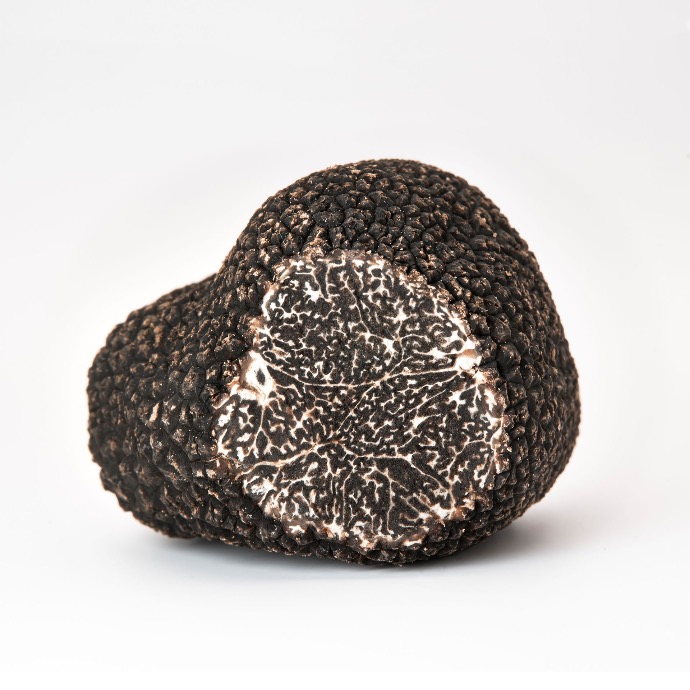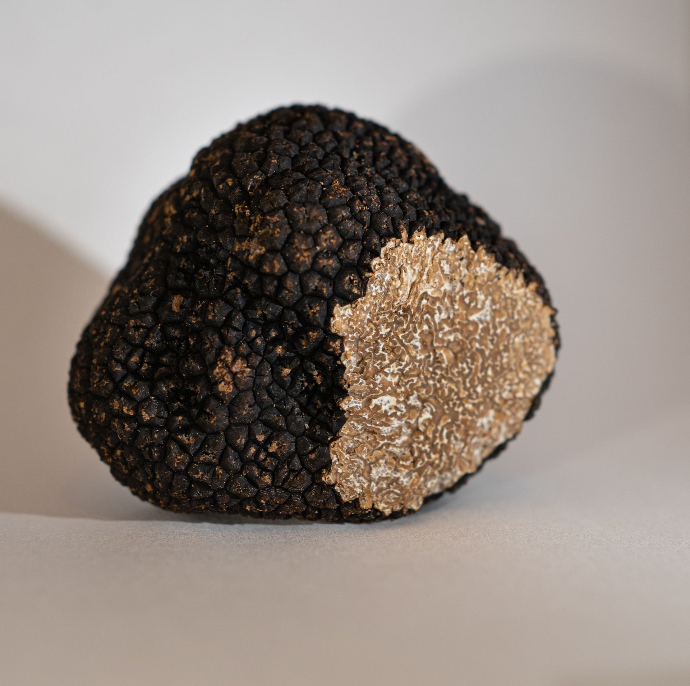Varieties & Seasons
Varieties
The truffle, a subterranean fruiting fungus (hypogeous), begins its growth in the form of hyphae, essential components of the renowned mycelium. These hyphae gradually close to form the future truffle, with the external part ensuring its protection, nourishment, and respiration. This growth process spans several months and is influenced by various factors, including the type of tree, the soil, and the weather conditions.
For enthusiasts, the distinction is often made between two types of truffles: the white and the black. However, there are actually many more varieties. The generic Latin term "tuber" may encompass about a dozen varieties, but only a few hold true gastronomic interest. Here is an overview of the truffles that captivate food lovers:
- Piedmont white truffle: Renowned for its intense aroma and garlic-like notes, it is a true culinary gem.
- Winter black truffle: Valued for its complex flavor, blending bitter chocolate, hazelnut, and black radish, it is often regarded as the queen of truffles.
- Summer black truffle: With its light woodland scent and subtle forest mushroom flavor, it is the most accessible of truffles.
- Autumn black truffle: Known for its woody aroma and flesh streaked with beige, it offers a perfect transition to the more intense truffles of winter.
Each of these truffles offers a unique tasting experience, enriching dishes with complex and refined flavors.
Piedmont white truffle
(Tuber magnatum pico)
The Piedmont white truffle, a true gem of gastronomy, is famous for its captivating aroma and subtle garlic notes. Enshrouded in mystery and rarity, this precious white diamond hides within the picturesque valleys of the Italian Piedmont.
Unique in its kind, it is the only truffle to display a white exterior, adorned with an elegant light beige hue. On the palate, it offers a refined tasting experience, subtly blending the flavors of black radish and wild garlic. It is the essence of sophistication.
On average, the white truffle weighs around 80 grams, although some exceptional specimens can exceed one kilogram. Its skin, or peridium, is a brownish white and relatively smooth. The color of its flesh varies depending on the tree it forms a symbiotic relationship with, with the best tubers found between the roots of oaks and linden trees. The majority of these precious truffles develop under the oaks and poplars in the surrounding forests of the charming town of Alba. In addition to Piedmont, it thrives, albeit to a lesser extent, in the rest of northern Italy and in Croatia.
With a limited annual production, its rarity justifies its high price. It reaches its full maturity between late October and late December, making this the ideal period to savor this exceptional delicacy.
Winter black truffle
(Tuber melanosporum vittadini)
The black truffle, often referred to as the queen of truffles, is a true delight for gastronomic enthusiasts. When it reaches full maturity, it displays a deep black color, with a size ranging between that of an egg and an apple. Externally, it is evenly dotted with small protuberances, while its flesh is marked by delicate white veins.
In Europe, the black truffle typically reaches its optimal maturity between late November and late March. Initially, its flesh is white, gradually transitioning through shades of gray as it matures, often reaching full maturity during the festive season with a distinctive black interior. If it has a reddish skin, this indicates that it is not yet fully ripe. Its intense, captivating aroma sets it apart from other truffles, and on the palate, it offers a soft texture with a unique flavor combining bitter chocolate, hazelnut, and black radish.
Known as "Melanosporum" or Périgord Truffle, it is found throughout much of the French soil. It is also widespread in Italy, the Balkans, and notably in Spain, which accounts for the majority of the global production. For the die-hard enthusiasts, excellent black truffles can also be found in New Zealand and Australia, allowing for the enjoyment of "winter" truffles during the summer months.
The black truffle requires a limestone, light, crumbly, well-drained soil and warmth. It forms a symbiotic relationship with the white oak or the evergreen oak, but also with hazel trees, walnut trees, sloe bushes, and field maples.
Summer black truffle
(Tuber aestivum vittadini)
The summer truffle, known as "scorzone" in Italian, is distinguished by its delicate, light woodland aroma and subtle flavor of forest mushrooms.
Although its flavor profile is more subtle than that of other truffles, it remains enjoyable and appreciated. It is the most widespread variety, growing at the base of oaks and in terrains similar to those of its winter counterpart.
As its name suggests, the summer black truffle is harvested during the warm season. Beneath its black skin lies a yellowish beige flesh, veined with white streaks, which sometimes leads to it being incorrectly called the white truffle. It is primarily found in Italy, France, Spain, and the Balkans. Due to its wide distribution, its production rates are significantly higher than those of its counterparts, making it the most accessible truffle, thanks to its lighter taste and aromas.
Its maturation period spans from early June to mid-September, providing a delightful summer alternative for truffle enthusiasts.

Autumn black truffle
(Tuber uncinatum)
The autumn truffle, commonly known as the "Burgundy truffle," is sometimes difficult to distinguish from its summer counterpart, earning it the nickname "late summer truffle." Compared to the summer truffle, its flesh is brown with beige streaks. It releases a subtly pleasant, woody aroma, although less pronounced than that of the winter black truffle.
The autumn black truffle is the most widespread in Europe, after the summer truffle. Like its summer predecessor, it can be found in Italy, France, Spain, and the Balkans. It forms a symbiotic relationship with a wide variety of trees, such as oak, hazel, hornbeam, beech, and pine, and is less demanding in terms of temperature and soil quality.
Until the Renaissance, the Burgundy truffle was the only one served at the royal tables of France. The fascination with the winter black truffle only emerged later, during the reign of François I.
Its maturation period spans from mid-September to mid-December, providing an ideal transition to prepare the palate for the more complex aromas and fragrances of the Piedmont white truffle and the winter black truffle.
Seasons
As a delicate food, the truffle’s maturation periods vary depending on climatic conditions and geographical location. Therefore, the maturity guidelines provided below are purely indicative. However, we are committed to offering our truffles for sale only when they have reached their full maturity, ensuring the quality of this exceptional product and your complete satisfaction.
To stay informed about the evolution of these maturation periods, we invite you to subscribe to our newsletter, to follow our Instagram account, or to contact us directly in store. We will be delighted to keep you informed about the latest news regarding our truffles and to offer you an exceptional gastronomic experience.




